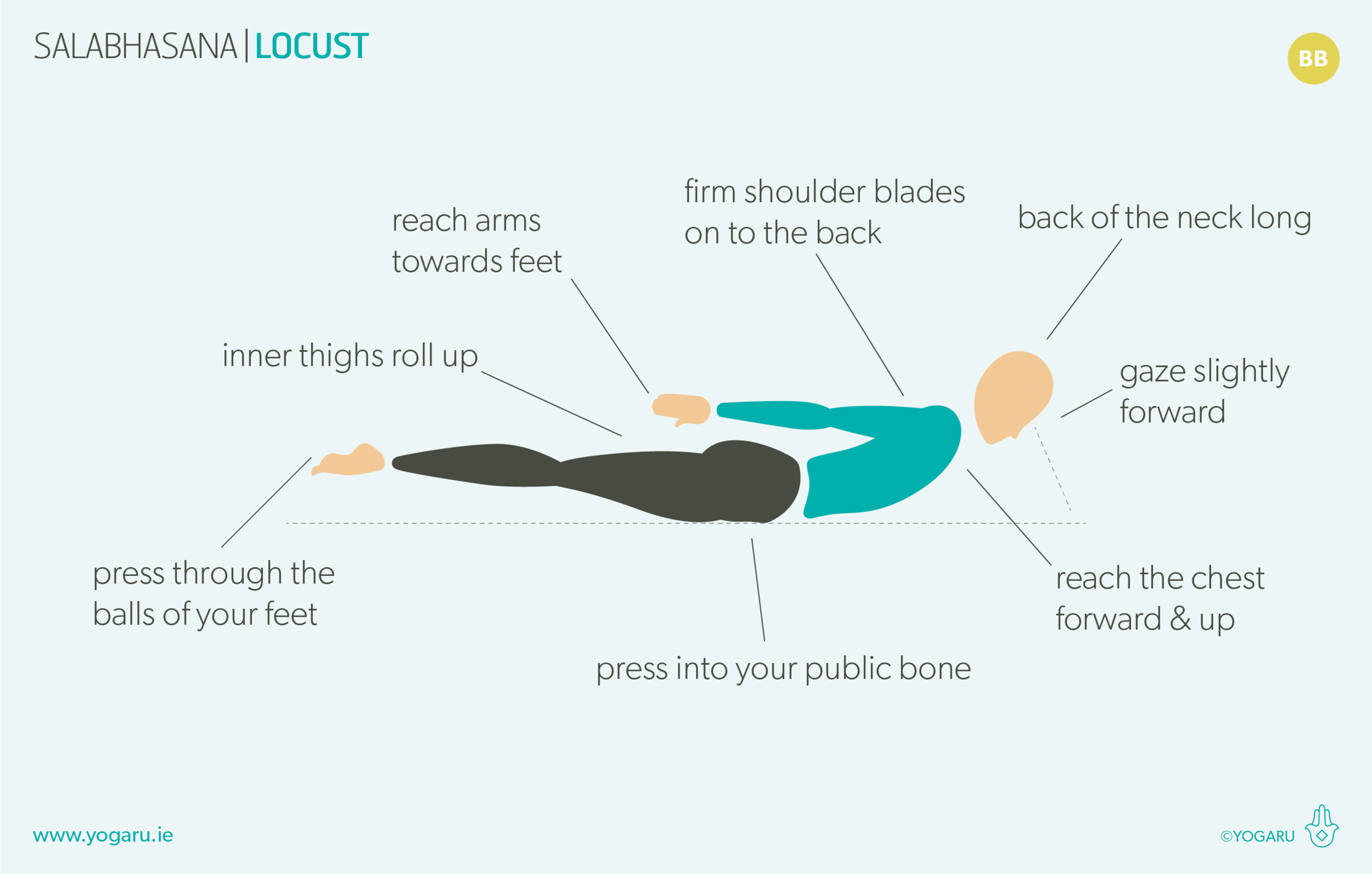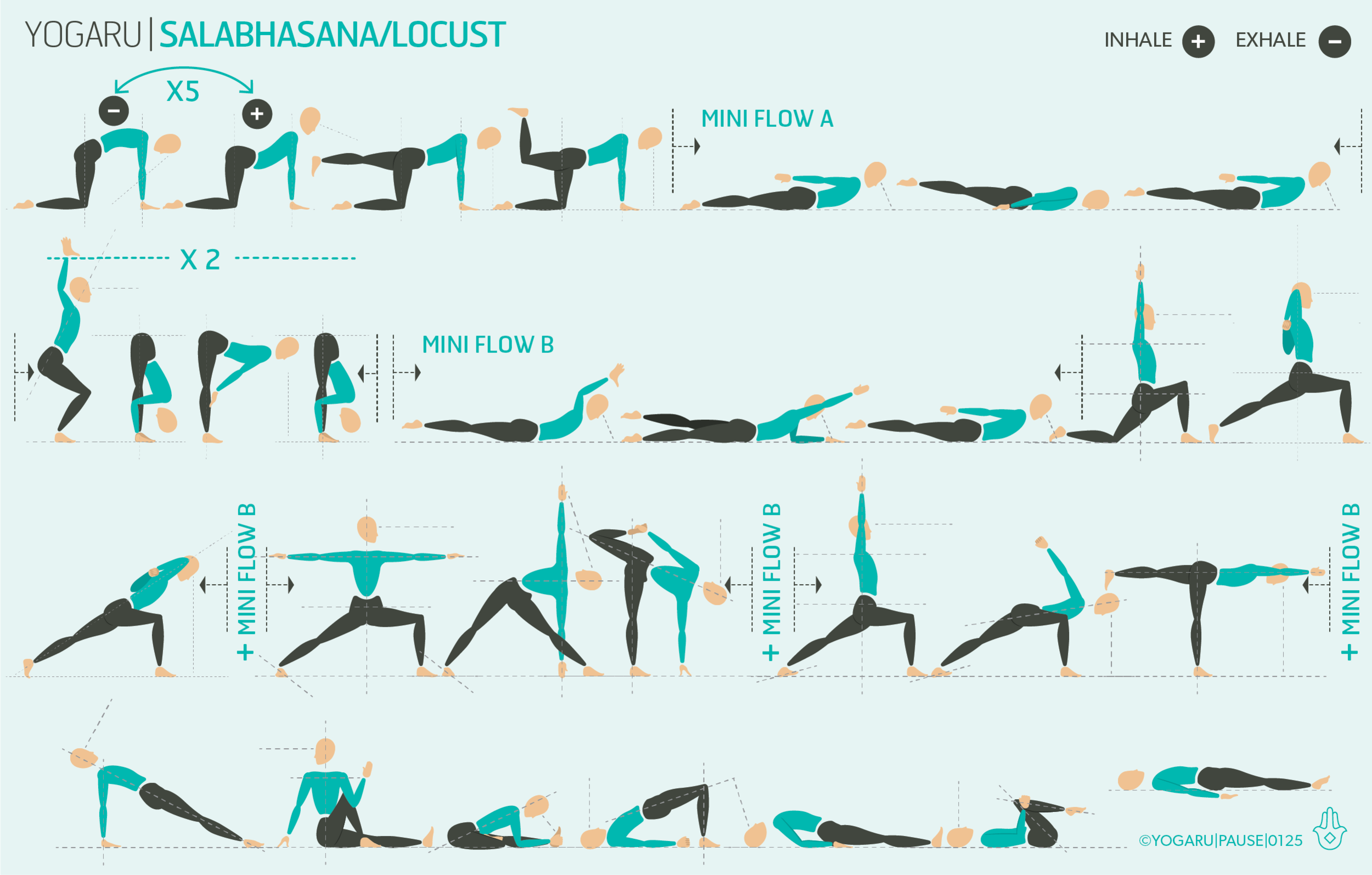BACK BODY STRENGTH
Salabhasana/Locust is by far my favourite backbend. I slot it into my vinyasas instead of Bhujangasana/Cobra to strengthen my whole back body, not just the muscles of my spine. ‘The posterior chain’ refers to the whole back body. It runs from the back of the heels up through the calves, hamstrings, glutes, lower back (lumbar spine), upper back (thoracic spine), neck (cervical spine) and ends just under the back curve of the skull (occipital curve). This chain of muscles are designed to hold us upright. If they are weak they become fatigued more easily and cause an overcurve of the upper spine and shoulders, resulting in a flattening of the lower spine as the body tries to compensate for the forward sway of the upper back and head. The posterior chain becomes weakened from lack of use or from long periods of sitting. A strong posterior chain protects the back and encourages good posture. In Salabhasana/Locust we are lifting the weight of the whole body against gravity which makes it a very strengthening pose for the posterior chain and the back of the arms. It also stretches the front of the shoulders, the chest, the belly and the front of the thighs. Although Salabhasana/Locust is quite a challenging pose to hold for more than a few breaths it is very accessible for beginners and is the perfect pose to prepare for deeper backbends.
THE BENEFITS OF SALABHASANA/LOCUST
The backbend family stimulates the nervous system, aids digestion, boosts circulation, boosts the immune system, and ease stress, tension, anxiety and mental fatigue. They also expand lung capacity and ease symptoms of asthma and sleep apnea. Backends that place pressure on your abdomen, like Salabhasana/Locust, have the added bonus of stimulating the organs of the body and aiding digestion by encouraging peristalsis in the muscles of the colon which help to push waste food along detoxing the body of food waste.
EXPLORING SALABHASANA/LOCUST IN YOUR PRACTICE
This sequence will give you plenty of opportunities to explore Salabhasana/Locust. Instead of linking your standing mini flows with a standard vinyasa you will come down to the ground and spend some time in a series of Salabhasana/Locust and Salabhasana versions. When you are moving through these poses use your public bone as your grounding anchor and see if you lightly draw your navel towards your spine. There is a temptation to puff the belly to fill the lungs and get higher but this will bypass the muscle activity of the back body. Stay lower and feel for the strength of the muscles all along the back body rather than striving for as much height as you can get.
ALIGNMENT CUES
There are two Salabhasana mini flows. You will take the Mini flow A as a warm up at the end of the first row and you will take the full Mini Flow B after each standing flow indicated by ‘+ MINI FLOW B’. Take your time in this section of your practice and remember this is the essence of this sequence.
Have a read of the tips below and either print out the sequence or save it onto your device:
Lie on your front, arms by your sides, palms facing your body, forehead resting on the ground.
Inhale, press into your pubic bone, lift your head, upper torso, arms and legs, lift with the whole back. Reach your chest forward and up.
Extend your arms towards your feet, lift your legs up and press through the balls of your feet, roll your inner thighs up.
Broaden through the collarbones, firm your shoulder blades onto your back, back of the neck long, gaze slightly forward.
Subscribe to my newsletter & get a FREE YOGA BENEFITS INFOGRAPHIC as a thank you!
To save the images for personal use click and hold down the image until the ‘save image’ option appears; on Mac hold down ‘control’ and click the image to get the option box; on PC right click on the image to get the option box. Scroll down in the ‘option box’ and click ‘save image’.
Ruth Delahunty Yogaru


